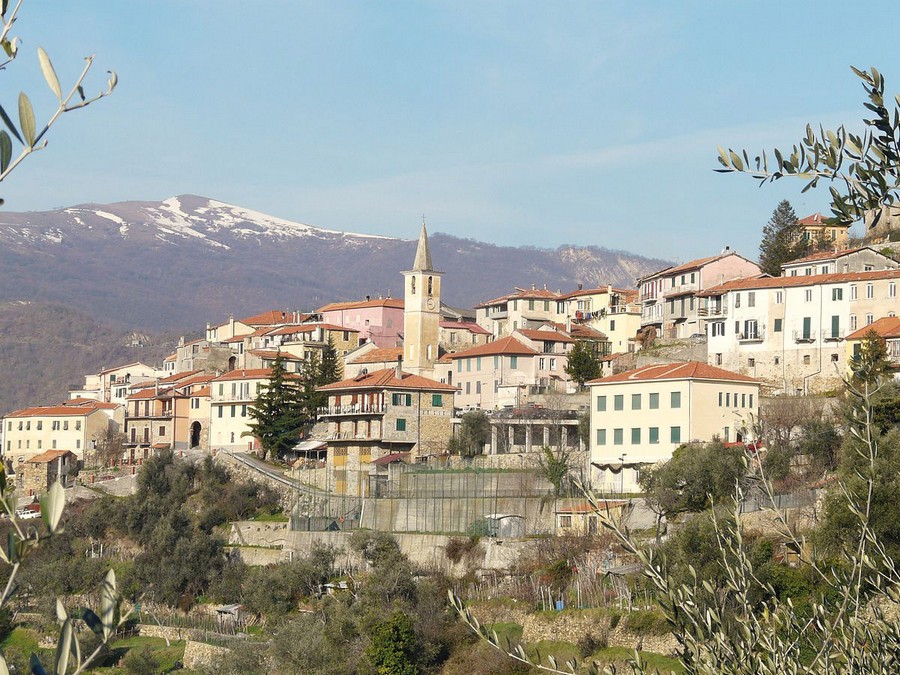Altitude: 512 m a.s.l.
Area: 9 sq km
Distance from Imperia: 19 km
Inhabitants: in 1881: 314 - in 2017: 279
Patron Saint Day: December 13th - Santa Lucia
Information: Municipality phone 0183 55920
Formerly a fief of the Marquis of Clavesana in the early Middle Ages, Cesio was ceded by them to the Republic of Genoa in the 14th century and was later purchased by the Savoys along with Oneglia.
In the early Middle Ages the town came under the control of the Albenga Committee, whose bishop extended his jurisdiction over the main centers of the Oneglia Valley, which he maintained until the end of the 13th century.
Cesio was then administratively a part of the ancient Castellania of Monte Arosio, which also included the villages of Gazzelli, Chiusanico, Torria and Chiusavecchia, in addition to the two centers of Val Merula, i.e. Testico and Poggio Bottaro, a district - to which was opposed the lower one of Bestagno - which results in particular from the deeds of sale of Oneglia to the Dorias in 1298 and from the ancient Statutes of the Valley of Oneglia.
During the thirteenth century the town had become a part of the domains of the counts of Ventimiglia, lords of the Maro, who erected a fortified structure in the hamlet of Cartari, which, together with those built on the Baraccone, Arosio and Torre mountains, constituted a dense network of military posts for the guarding and surveillance of the orographic junctions above the stretch of coast between Capo Santa Croce, near Alassio, and Capo Berta.
In 1233 the village participated with other towns of the valley in the foundation of Pieve di Teco, while at the beginning of the following century Cesio was sold by Count Oberto of Ventimiglia, lord of the Maro, to Federico Doria for the sum of 1600 Genoese pounds with a deed stipulated on October 9, 1301.
In 1576 the town was then sold by the Dorias del Maro to the duke Emanuele Filiberto of Savoy together with the village of Arzeno, while Cartari remained under the dominion of the Republic of Genoa.
During the following centuries, despite wars and famines, the town experienced a period of considerable economic and demographic development until the period of the French domination, when in 1800 on Monte Mucchio di Pietre the Austro-Piedmontese inflicted a heavy defeat on the French republican troops.
The following year the village was subjected to a violent looting by a gang of about five hundred predators coming from the Valley of Oneglia and from the side slopes of the streams Lerrone and Arroscia, who, under political pretext but in reality with the sole aim of preying , invaded Cesio, scaring away the terrified inhabitants and thus allowing themselves to looting houses and killing the few sick ones who had not been able to save themselves, as well as to slaughter and make prey of cattle.
Visit of the town
At the center of the village stands the Baroque church of Santa Lucia on whose churchyard a curiosity survives: a fascist plaque with its two fascist emblems, which recalls "the siege" (the well-known "sanctions") suffered by imperialist Italy in the hunt of a "place in the sun".
In the hamlet of Cartari there are ruins of a fortress.
Continuing beyond Cesio, if you turn right at the crossroads you can reach, on a naturalistic excursion through the woods, the Ginestro Pass with a panoramic view of the sea and from there descend to Andora, or to Alassio, or (as already seen) also to Albenga.
In Arzeno the bell tower is a former medieval tower and the village still preserves the structure of the period.
Taking instead the left, you’ll arrive to Colle San Bartolomeo (620 m a.s.l.) from which you can descend on the right to Pieve di Teco.


